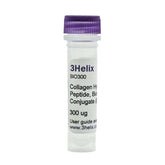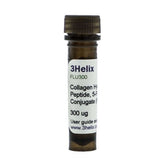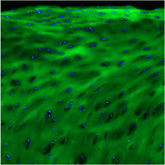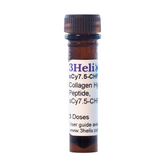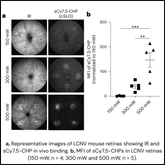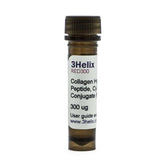Utilizing Collagen Hybridizing Peptides to Assess Collagen Integrity in a Senolytic Therapy Model for Intervertebral Disc Degeneration
Extracellular matrix (ECM) degradation, particularly damage to structural collagen, is a hallmark of numerous pathologies, including Intervertebral Disc (IVD) degeneration. Assessing the structural integrity of collagen in situ is critical for understanding disease mechanisms and evaluating the efficacy of potential interventions. Collagen Hybridizing Peptides (3Helix, Inc.) offer a unique tool for this purpose, specifically targeting damaged collagen molecules (diagram below).

A compelling application of Collagen Hybridizing Peptide technology was demonstrated in a study by Novais et al., published in Nature Communications (2021), investigating a senolytic therapy for age-related IVD degeneration in mice models. This work provides an excellent case study on how CHPs can be integrated into preclinical research to provide specific molecular insights into the ECM.
Armed with the knowledge that cell senescence contributes to IVD degeneration, the research by Novais et al., sought to clear senescent cells using a Dasatinib and Quercetin (D+Q) treatment to potentially mitigate effects of IVD degeneration.
C57BL/6 mice received D+Q treatment starting at various ages, and their discs were analyzed at 23 months of age. The study found that D+Q treatment, especially when initiating treatment between 6 and 14 months, successfully reduced histological signs of degeneration, decreased senescence markers, lowered key SASP factors, improved cell viability, and modulated ECM composition markers. Given these positive effects on cellular health and ECM markers, a key question remains: Does the senolytic therapy also impact the structural integrity of the existing collagen matrix?
CHP Application: Probing Collagen Damage in Situ
Continue Reading
To directly assess damage to the existing collagen matrix, the researchers employed our green fluorescently-labeled Collagen Hybridizing Peptides (F-CHP). CHPs function as unique probes specifically binding to unfolded collagen molecules, present in damaged and remodeling tissues, while having negligible affinity for intact collagen molecules. In the Novais et al. study, F-CHP staining was performed on paraffin-embedded, mid-coronal IVD sections from the 14-23 month treatment cohort (Vehicle vs. D+Q) and 1-year-old healthy controls 1 . Binding was visualized and quantified using fluorescence microscopy (see figure below).

a Bright field and chemical map of mean second-derivative peaks for collagen (1338 cm−1). Red: high relative absorbance; yellow: intermediate relative absorbance; blue: low relative absorbance. b Quantification of mean second-derivative peaks for collagen (1338 cm−1). c Quantification of the percentage of presence/absence of collagen fibers within the NP compartment. d 1-year Ctr, Veh and D + Q lumbar discs showing collagen fiber organization under bright field and polarized light (scale bar = 100 μm). e Quantification of collagen fiber thickness distribution and proportion in the AF. f Denatured collagen, measured by a collagen hybridization peptide (CHP) biding assay (scale bar = 200 µm). Two-tailed ANOVA or Kruskal–Wallis tests were used as appropriate; n = 6 mice/group, 2–3 levels per mouse were analyzed. Data are represented as mean ± SEM. Source data are provided as a Source Data file.
CHP Findings: Specific Insights into Matrix Damage
The quantitative analysis of F-CHP fluorescence intensity revealed no statistically significant differences in denatured collagen levels between the D+Q-treated group, the vehicle-treated control group, and the younger healthy controls.

Interpreting the CHP Result: Understanding the Mechanism of Action
This finding, using the precision of CHP technology, provides valuable mechanistic insight. While the D+Q senolytic therapy demonstrated clear benefits in reducing cellular senescence and modulating the expression of certain ECM components and degradation markers (like MMP13 and ARGxx), the CHP results indicates that this intervention did not significantly reduce the burden of existing, structurally denatured collagen within the disc matrix in this specific model and timeframe.
This underscores the specificity of CHP as a tool for detecting conformational collagen damage. It suggests that D+Q's matrix-protective effects likely arise primarily from other mechanisms, such as reducing the inflammatory SASP, inhibiting enzymatic degradation pathways, and potentially improving matrix synthesis by healthier resident cells, rather than directly facilitating the repair or removal of already-unfolded collagen molecules.
The CHP result, showing no difference between groups was therefore crucial. It helped delineate the specific aspects of ECM homeostasis that were, and were not, directly impacted by the D+Q treatment in this context, complementing the information gained from other assays.
Conclusion: CHP as a Precision Tool for ECM Research
The Novais et al. study exemplifies how 3Helix's Collagen Hybridizing Peptide technology serves as a precise tool for evaluating collagen structural integrity in situ. By specifically targeting denatured collagen, CHP provided unique molecular information that helped refine the understanding of how senolytic therapy impacts the IVD matrix. Even when revealing no change between experimental groups, CHP delivers valuable data, aiding researchers in dissecting complex biological processes and therapeutic mechanisms of action.
For researchers investigating ECM pathologies, tissue repair, fibrosis, or evaluating novel therapeutics impacting collagenous tissues, CHP offers a targeted approach to quantify structural collagen damage, complementing traditional histological and biochemical methods.
Full Paper:
|
Novais, E.J., Tran, V.A., Johnston, S.N. et al. Long-term treatment with senolytic drugs Dasatinib and Quercetin ameliorates age-dependent intervertebral disc degeneration in mice. Nat Commun 12, 5213 (2021). https://doi.org/10.1038/s41467-021-25453-2
|
|
